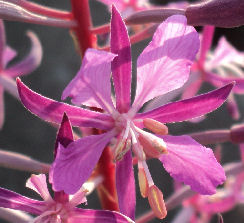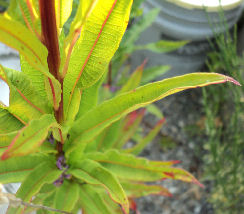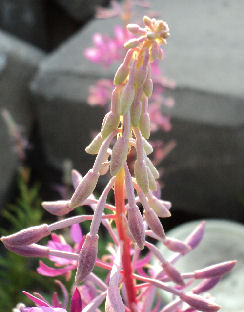|
|
|
|
|
|
| Practical ecological knowledge for the temperate reader. |
Willowherb - Epilobium angustifolium
- Family: Onagraceae (Evening Primrose family)
- Other names: Fireweed [E-flora]
Description
Synonyms
- Chamaenerion angustifolium subsp. circumvagum (Mosquin) Moldenke [E-flora]
- Chamerion angustifolium var. canescens (Alph. Wood) N.H. Holmgren & P.K. Holmgren [E-flora][WildPNW]
- Chamerion danielsii D. Löve [E-flora]
- Chamerion platyphyllum (Daniels) A. Löve & D. Löve [E-flora]
- Epilobium angustifolium subsp. circumvagum Mosquin [E-flora]
- Epilobium angustifolium subsp. macrophyllum (Hausskn.) Hultén [E-flora]
- Epilobium angustifolium var. abbreviatum (Lunell) Munz [E-flora]
- Epilobium angustifolium var. canescens Alph. Wood [E-flora]
- Epilobium angustifolium var. macrophyllum (Hausskn.) Fernald [E-flora]
- Epilobium angustifolium var. platyphyllum (Daniels) Fernald [E-flora]
General "...growing to 2 m (6ft) by 1 m (3ft 3in) at a fast rate." [PFAF]
Lifecycle Perennial. [IFBC][E-flora]
Flowers "The flowers are hermaphrodite (have both male and female organs) and are pollinated by Bees." [PFAF] "Inflorescence a many-flowered, terminal raceme..."[IFBC] [E-flora] "petals 8-25 mm. long, rose-colored;" [HNW] Rose to purple. [PCBC2004]
Fruits "Capsules, 4-10 cm long, densely short-hairy..."[IFBC][E-flora] "...narrow, green to red, 4 chambered..." [PCBC2004]
Leaves "Alternate, narrowly lanceolate..."[IFBC] [E-flora] "...deep green above, paler beneath..." [HNW] "...hairless and distinctly veined below..." [PCBC2004]
Stem "stems erect, often reddish".[HNW] Leafy, usually unbranched.[PCBC2004] "...short stiff hairs on upper part." [WildPNW]
Root Rhizome-like root.[IFBC][E-flora]
Habitat "...meadows, roadsides, burns, clearings and waste places..."[IFBC][E-flora] "...edges of open woods..." [HNW]
Range "abundant throughout BC (ssp. circumvagum more common along coast than interior); circumboreal..." [IFBC][E-flora] "...only locally abundant on the outer coast." [PCBC2004] Pacific States. [PSW]
Status Native [E-flora][WildPNW]
Ecological Indicator "...very shade-intolerant.... Grows on recently cutover and/or burnt sites... Scattered to abundant (often dominant) in herbaceous communities on a wide range of sites where it indicates increased decomposition of the remaining forest floor materials (originally Mor humus forms). In some situations, high-density stands of this species may hinder the survival and growth of forest plantations. Commonly associated with Polytrichum juniperinum. A nitrophytic species characteristic of fire-disturbed sites."[IPBC][E-flora]
Hazards
- "An infusion of the leaves is said to stupefy a person[4]." [PFAF]
Food
- "This plant, especially the young shoots were widely eaten by aboriginal peoples. The Haida formerly ate large quantities of fireweed, and regarded it as a healthful spring tonic." [Turner, Kuhnlein]
- Greens: "Leaves and young shoot tips - raw or cooked[2, 5, 12, 62, 172, 183]. They can be used in salads or cooked as a vegetable[9]. When boiled they make a wholesome vegetable and are a good source of vitamins A and C[2, 257]. Only use the leaves when they are young[85]." See caution [PFAF] "The tender leaves can be stripped off and treated as a potherb. We found them very palatable, but inclined to develop a bitterness when they became too old." [Harrington]
- Tea: The young leaves boiled to make a refreshing tea. [Turner&Bell] Slightly sweet in flavor. Can be slightly laxative. Called Kaporie in Russia. Late spring. [Schofield]
- Young Shoots: "Young shoots - cooked. They make a good asparagus substitute[2, 9, 183, 213]." [PFAF] The young, peeled shoots were eaten raw or boiled. The Inupiaq Eskimo cooked them or preserved them raw in seal oil; sometimes they were dried a little first. They were eaten with oil, fish or meat. Usually the stems were cleaned of leaves, then split open lengthwise with the thumbnail and the inner part scraped off and eaten. Recently, some people have liked to sprinkle the shoots with a little sugar before eating. The peeled stems were eaten raw or roasted with ooligan grease. Sometimes the shoots were mixed with other greens. [Turner, Kuhnlein] The young shoots can be cooked like asparagus. [Harrington]
- Older Plants: "If the leaves and shoots are too old the plant can still be used. Try drying the mature leaves and using them for tea." "The mature plants can be gathered and the bark peeled away from the central pith. This core is slightly sweet, tender, and pleasant to the taste when eaten raw. We found the stems difficult to peel and the remaining pith disappointingly narrow." Pith "...used by some to flavor and thicken stews and soups." [Harrington]
- Stem Pith: "The pith of young or older stems - raw or cooked[62, 99, 183]. Slightly sweet, tender and pleasing to eat, though there is not much of it[85, 172]. Gelatinous[161], it can be used as a flavouring in soups[183]. The stems are said to be a good laxative, but are best not eaten on an empty stomach[256]." [PFAF]
- Roots: The fresh roots were eaten by the Blackfoot.[Turner, Kuhnlein] "Root - raw, cooked or dried and ground into a powder[74, 172]. Used in spring, it has a sweet taste[12, 74]." [PFAF] "The edible roots were split open and eaten raw..."[Turner&Bell]
- Flower Stalks: Used them in combination with other plants as a salad. They can also be cooked.[Harrington] "Flower stalks - raw or cooked[85, 106, 172, 183]. Added to salads, they are used when the flowers are in bud[183]." [PFAF]
- Flowers: "The flowers were eaten raw as a confection." [Turner, Kuhnlein]
Other Uses
- Fodder: The Inland Tanaina mixed cooked fireweed greens with dogfood. Fireweed was considered to be good food for deer and horses.[Turner, Kuhnlein]
- Fibre: "A fibre obtained from the outer stems is used to make cordage[99, 207, 256]." [PFAF]
- Down: "The 'cottony' seed hairs are used as a stuffing material[99, 118] or as a tinder[106, 172]." [PFAF] The fluffy seeds were mixed "...with dog wool for weaving baskets, or with duck feathers to make mattresses." [Turner&Bell] At least one group "...wove fireweed down with the wool of mountain goats."[Schofield]
- Skin Warming: "The powdered inner cortex is applied to the hands and face to give protection from the cold[99, 172, 257]." [PFAF]
- Repellent: The Upper Tanana of North America used smoke from burning shoots as a mosquito repellent and to smoke their fish (Kari 1985).[UAPDS]
Medicinal Uses
"Willow herb is often used as a domestic herbal remedy, though it is little used in conventional herbalism. The herb is antispasmodic, astringent, demulcent, emollient, hypnotic, laxative and tonic[4, 7, 172, 192]. It is used in the treatment of diarrhoea, mucous colitis and irritable bowel syndrome[254]. The plant is used in Germany and Austria to treat prostate problems[254]." [PFAF]
- Leaves: "A poultice of the leaves is applied to mouth ulcers[222]. An extract of the leaves has anti-inflammatory activity[222]. An ointment made from the leaves has been used to soothe skin problems in children[254]." [PFAF] "Fireweed leaves and flowers, steeped in oil, are reported to be an excellent external application for piles." [Schofield]
- Tea: "A tea made from the leaves and roots is a folk remedy for dysentery and abdominal cramps[222]." [PFAF] "Fireweed tea is used freely by those troubled by constipation. Infusions are also recommended as spring tonics, and to settle upset stomach." [Schofield]
- Root: "A poultice made from the peeled roots is applied to burns, skin sores, swellings, boils etc[222, 257]." [PFAF] "The root of this plant is used to make a wash for swellings.... With the white men it is a demulcent, tonic and astringent. It has been used for its tonic effect on mucous surfaces and its value in intestinal disorders." [HuronSmith Menomini]
- Tumors: "The woolly pappus of the fireweed seed was mixed with eagle down and catfish oil and applied to wounds made when tumors were cut open (Boas, 1966)." [Turner&Bell]
Ethnobotany
Cooking Pit: The leafy stems interspersed between layers of food in cooking pits.[Turner&Kuhnlein]
Cooking Tools: "Coast Tsimshian people sometimes used the fibrous outer part of the stem as a soapberry whipper and sweetener. They also added the sweet "syrup" from the stems to drying berry cakes as a "glue"."[Turner&Kuhnlein]
Fiber: "The stringy fibers that remain after drawing split fireweed stems through the teeth to extract the marrow were woven into twine and fishnets." [Schofield]
Waterproofing: The blackfoot "...rubbed fireweed flowers on mittens and rawhide thongs as waterproofing." [Schofield]
Intoxicant: "...fireweed was processed into a stupefying ale (common in Kamchatka in the 1800s); In A Modern Herbal, Grieve mentions this was prepared from boiled fireweed pith, cow parsnip stems, and the hallucinogenic fly agaric mushroom (Agaracus muscarius)." [Schofield]
Nutritional
Nutritional Facts
Per 100g Leaves (Fresh weight)
serving size 1
[Turner&Kuhnlein]
|
Ash (g) 1.8
Carbohydrate (g) 2.9
Crude Fiber (g) 1.4
Protein (g) 6.5
Water (g) 76
| Vitamins
Vitamin A (RE) 22
Vitamin C (mg) 88
| Minerals
Calcium (mg) 175
Copper (mg) 0.2
Iron (mg) 2.7
Magnesium (mg) 70
Manganese (mg) <0.1
|
Molybdenum (mg) <0.1
Phosphorus (mg) 132
Potassium (mg) 404
Sodium (mg) 50
Zinc (mg) 0.9
|
Nutritional Facts
Per 100g Peeled Shoots (Fresh weight)
serving size 1
[Turner&Kuhnlein]
|
Ash (g) 0.5
Carbohydrate (g) 4
Crude Fiber (g) 0.9
Fat (g) 0.3
Food Energy (Kcal) 17
Protein (g) 0.2
Water (g) 92
| Vitamins
Vitamin A (RE) 4
| Minerals
Calcium (mg) 32
Copper (mg) 0.7
Iron (mg) 0.5
Magnesium (mg) 20
Manganese (mg) 0.1
|
Phosphorus (mg) 31
Sodium (mg) 0.6
Zinc (mg) 0.7
|
Pharmacology
- Alpha-Reductase Inhibitor (1; X9140222) [HMH Duke]
- Antibacterial (1; PHR; PH2) [HMH Duke]
- Anti-BPH (1; PHR)[HMH Duke]
- Antiedemic (1; PHR; PH2)[HMH Duke]
- Antiexudative (f; PHR; PH2)[HMH Duke] Epliobium Sp. including E. angustifolium.''[PDR]
- Antiinflammatory (1; FAD; PHR; WOI) [HMH Duke]
- antiphlogistic - Epliobium Sp. including E. angustifolium.''[PDR]
- Antiprostaglandin (1; X1775578) [HMH Duke]
- Antiprostatitic (1; X9140222) [HMH Duke]
|
- Antiseptic (1; PHR; PH2) [HMH Duke]
- Antitumor (f; PHR)[HMH Duke]
- Aromatase Inhibitor (1; X9140222)[HMH Duke]
- Astringent (1; FNF; WOI) [HMH Duke]
- Candidicide (1; PHR; PH2) [HMH Duke]
- Laxative (f; DEM) [HMH Duke]
- Panacea (f; DEM)[HMH Duke]
- Toxic (f; DEM)[HMH Duke]
|
"All the extracts examined were rich in phenols (over 10%, w/w) and total phenol content correlated well with antioxidant activity in all tests.... Water extract of flowers demonstrated highest antioxidant activity. Potent antioxidant activity, together with pronounced antimicrobial activity of ethanolic extract, may support the use of E. angustifolium in treatment of prostatitis and benign prostatic hyperplasia." [Antimicro]
"A suspension of the fresh drug in ethanol stunts the growth of the bacteria of Pseudomonas pyocyanea." [PDR]
"Tincture and the liquid extract showed anti-microbial effect against Candida albicans, Staphylococcus albus and Staphylococcus aureus."[PDR]
"The dried residue of a maceration, which is fixed on filter paper, shows a weak effect against Bacillus subtilis, Escherichia coli, Mycobacterium smegmatis, Shigella flexneri, Shigella sonnei and Staphylococcus aureus."[PDR]
|
Phytochemistry
|
Flavonoids
- myricitrin [PDR]
- isoquercitrin [PDR]
- quercitrin [PDR]
- guaiaverin [PDR]
- quercetin-3-O-beta-D-glucuronide [PDR]
|
Palmitate [PDR]
Steroids:
- beta-sitosterol and its ester [PDR]
- beta-sitosterol caproate [PDR]
Tannins [PDR]
|
Cultivation
"An easily grown plant, it prefers a well-drained but moisture retentive soil in a sunny position[200], though it succeeds in most soils[1]. It prefers a moist soil[111], but also succeeds on dry banks[188]. It is best grown in open woodland[1]. Plants are hardy to at least -20°c[187]. The rosebay willowherb spreads vigorously by means of a creeping rhizome, and often forms large patches[187]. It is apt to become a weed especially through its seed which is very light and capable of travelling long distances in the wind. It is often one of the first plants to colonize disturbed areas such as scenes of fires[1, 200]. A very ornamental plant[1], it is the floral emblem of the Yukon[172]. A food plant for the caterpillars of several lepidoptera species[24], it is also a good bee plant[74, 94]."[PFAF]
Propagation
"Seed - sow early spring in situ or as soon as the seed is ripe[111]. This plant is more than capable of finding its own way into most gardens and does not usually require an invitation. Division in spring or autumn. Very easy, larger clumps can be replanted direct into their permanent positions, though it is best to pot up smaller clumps and grow them on in a cold frame until they are rooting well. Plant them out in the spring." [PFAF]
Epilobium Sp.;
- Herb & Root; antiphlogistic and antiexudative. "...helpful in treating benign prostate hyperplasia and certain micturition disorders." Also for treating "...gastrointestinal disorders and mucous membrane lesions of the mouth. Native Americans use the drug for rectal bleeding; the Chinese use it for menstrual disorders. The watery extract is used externally to improve the healing of wounds." Used "...as a tea, watery extract or as a vegetable." [PDR]
E. latifolium - River Beauty:
"...used like the common species, and preferred to it by some people." We found some of the smaller species of Epilobium acceptable.[Harrington]
Nutritional: Leaves Per 100 g (fresh weight), Riboflavin (mg) 0.54, Magnesium (mg) - Water (g) 78, Niacin (mg) 1.4, Protein (g) 3, Vitamin C (mg) 128, Fat (g) 0.8, Vitamin A (RE) 1700, Iron (mg) 2.1, Carbohydrate (g) 6.3, Calcium (mg) 13, Phosphorus (mg) 89, Ash (g) 1.6, Thiamine (mg) 0.4.[Turner&Kuhnlein]
Inner Stems: Used same as fireweed.[Turner&Kuhnlein]
Young Leaves: Picked in spring and preserved in seal oil to be consumed within 2 days. They turn black and slimy if stored longer. The leaves have been fermented and eaten with walrus blubber.[Turner&Kuhnlein]
Flowers: Consumed raw, along with the leaves and seal blubber.[Turner&Kuhnlein]
Roots: Raw roots are a popular food of the Siberian Eskimos. Fall [Schofield]
Buds: Used same as young leaves. [Schofield]
Stalks: Raw, steamed,or stir-fried. Variable flavor. Can be made less potent by pickling. [Schofield]
References
- E-flora - http://linnet.geog.ubc.ca/Atlas/Atlas.aspx?sciname=Epilobium_angustifolium&redblue=Both&lifeform=7 , Accessed: 12/2/2014
- PFAF - http://www.pfaf.org/user/Plant.aspx?LatinName=Epilobium+angustifolium, Accessed March 29, 2015
- Antimicro - Antioxidant and antimicrobial activity of willow herb (Epilobium angustifolium L.) I Kosalec, M Zovko, K Sankovic, D Kremer, S Pepeljnjak, Planta Med 2008; 74
- HuronSmith Menomini - Ethnobotany of the Menomini Indians, Huron H. Smith, Bulletin of the Public Museum of the City of Milwaukee, Vol. 4, No.1, December 10, 1923
- Turner&Bell - The Ethnobotany of the Coast Salish Indians of Vancouver Island, Nancy Chapman Turner & Marcus A. M. Bell, Department of Biology, University of Victoria, Victoria, British Columbia, Canada. Submitted for publication 9 June 1969.
Page last modified on
Monday, July 12, 2021 8:07 PM





